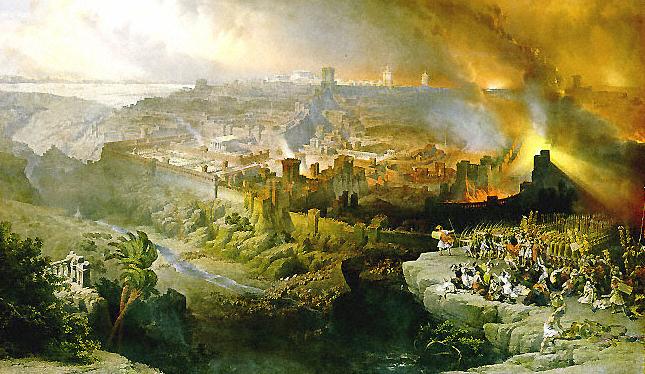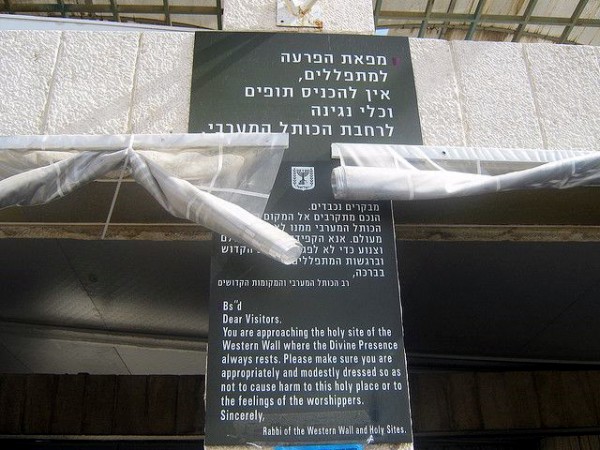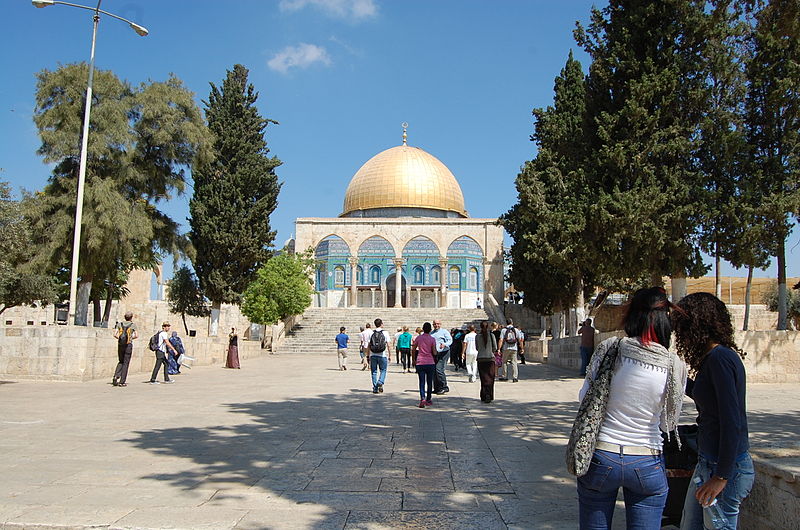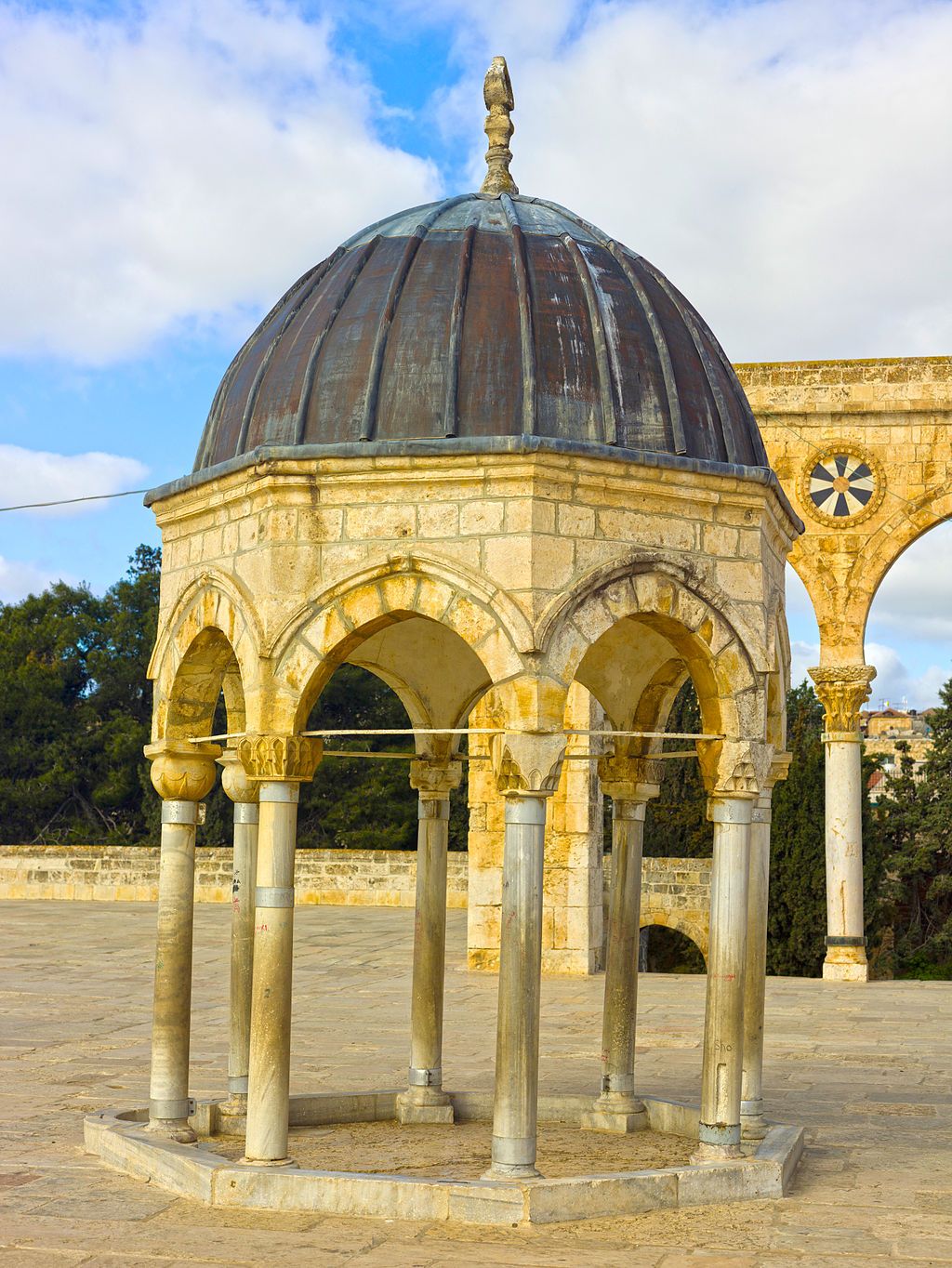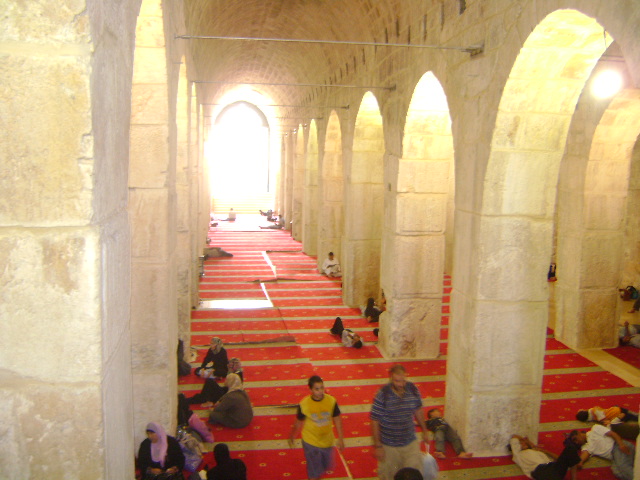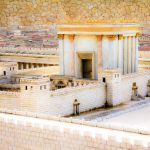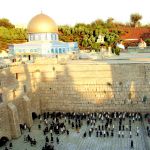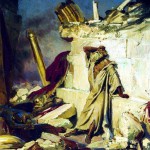“Nebuchadnezzar king of Babylon came with all his army against Jerusalem and laid siege to it. And they built siege works all around it.” (2 Kings 25:1)
Many people have had visions from the Lord and experiences of the Ruach HaKodesh (Holy Spirit) at the Wailing Wall.
One Catholic woman had her first and only vision there. While alone visiting the Wailing Wall (Kotel), she saw the stones come alive, and they were dancing before her eyes.
She thought she was going crazy.
Someone in the crowd came up to her out of the blue, and handed her a New Testament which was opened to Luke 19:40 and told her to read it: “Some of the Pharisees in the crowd said to Yeshua (Jesus), “Teacher, rebuke your disciples!” Yeshua replied: “I tell you, if they keep quiet, the stones will cry out.”
She then fell face down and received Yeshua, was instantly born-again. She felt the Divine Presence of the Holy Spirit coming upon her and filling her.
A Jewish teenager wrote into our ministry telling us that while he was standing at the Wailing Wall, he felt a force of energy come down upon him, enveloping him from the top of his head to the bottom of his toes.
“This beautiful spiritual force circled around my body, I didn’t know God, but I knew it was God, and I believe now that God’s Presence is at the Temple Mount and the Kotel (Wailing Wall),” he said.
Later, he discovered Yeshua in the Messianic Prophecies.
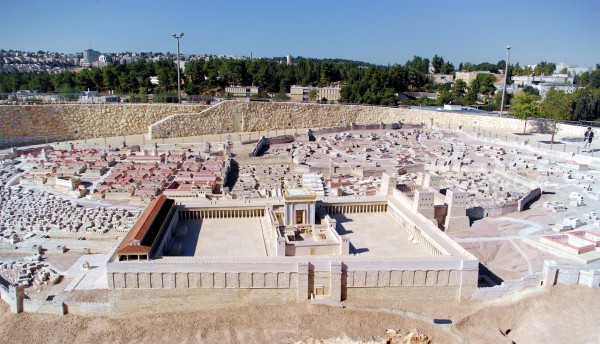
This model of the Second Temple Mount is in Jerusalem. Herod was not satisfied with the dimensions of the Temple Mount, so he expanded its platform. His engineers are thought to have constructed the enormous platform on vaulted arches to reduce pressure on the retaining walls.
Today at sunset, Tzom Tammuz (Fast of Tammuz / 17th of Tammuz) begins, which memorializes the breaching of Jerusalem’s walls by Nebuchadnezzar after a long siege that brought starvation to those inside Jerusalem’s walls.
On 17th of Tammuz the priests in the First Temple stopped offering the Tamid (Perpetual Offering) because the walls were breached, and they had run out of lambs for the offerings. Within weeks, the First Temple was destroyed and all the houses burned. The majority of the Jewish people were taken captive.
Several hundred years later, in AD 70, after a lengthy Roman siege, the walls of Jerusalem were once again breached. Once again, it was the 17th of Tammuz.
“On the ninth day of the fourth month the famine was so severe in the city that there was no food for the people of the land. Then a breach was made in the city, and all the men of war fled by night.” (2 Kings 25:2–4)
Between the Straits
“Judah has departed into exile under affliction and harsh oppression. She lives among the nations; she has found no resting place. All who pursued her overtook her in narrow straits [metzar].” (Lamentations 1:3)
The 17th of Tammuz also marks the beginning of a three-week mourning period called The Three Weeks or Bein ha-Metzarim (In Dire Straits or Between the Straits).
The Three Weeks end on yet another fast day called Tisha B’Av (the Ninth of Av), which will fall on July 15th this year.
Tisha B’Av commemorates the greatest tragedy in Jewish history—the destruction of the First and Second Temple. Each were destroyed on the same day many years apart, the First Temple by the Babylonians in 586 BC, and the Second Temple by the Romans in AD 70.
Continued Holiness of the Temple Mount
Even though the Second Temple was destroyed in AD 70, it has never stopped being important to the Jewish People.
In fact, the Temple is central to Judaism. Nearly two-thirds of the 613 commandments found in the Torah cannot be observed without the Temple. (Chabad)
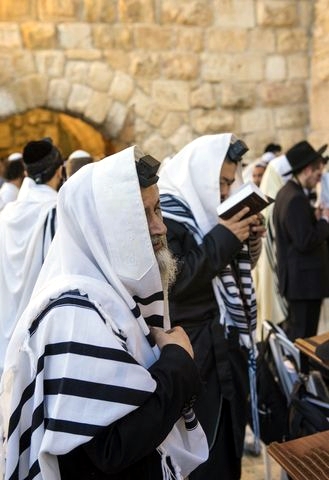
Today prayer continues night and day at the Western Wall, which is a section of the Temple Mount retaining wall and therefore, considered holy.
The Temple Mount is also revered as holy and is considered the only place in the world inherently holy from the beginning of time.
“The Creator sanctified this place before our creation, at the time of Creation,” said Rabbi Chaim Richman. (Universal Torah Network)
“Despite the fact that the Temple was destroyed, the sanctity of the Temple Mount never waned,” he said.
In remembrance of the Temples, Jews today climb the Temple Mount to connect with the continued holiness of the site.
Some climb the holy site to pray, even though Jewish prayer has been banned by the Muslim Waqf, who were named administrators of the Temple Mount by former Israeli Minister of Defense Moshe Dayan following the reunification of Jerusalem in 1967’s Six Day War.
“To members of the other religions, Christians and Muslims, I hereby promise faithfully that their full freedom and all their religious rights will be preserved. We did not come to Jerusalem to conquer the Holy Places of others,” Dayan said.
Major Stumbling Block
Administrative control of the Temple Mount by the Waqf has made it difficult to protect against a widespread rewriting of history by many leading Islamic voices, who attempt to weaken the Jewish connection to the Temple Mount and to the Land of Israel on the international scene. In fact, control of the Temple Mount where the First and Second Temples stood has become a key issue and major obstacle to peace.
During the Middle East Peace Summit at Camp David in July 2000, Israel offered to give up governmental control of the Mount if Yasir Arafat and the Palestinians would recognize the sacredness of the Temple Mount to Judaism—but they refused. (CAMERA)
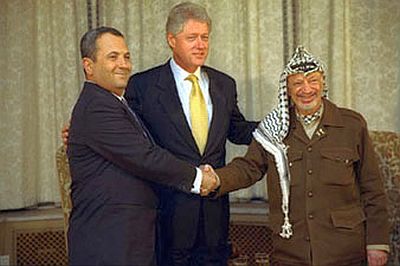
Israeli Prime Minister Ehud Barak (left), United States President Bill Clinton (middle) and Palestinian Authority Chairman Yasser Arafat (right).
Giving administrative control to the Waqf has resulted in a refashioning of Arab history, which has created confusion in new generations of Arabs.
Ala Wahib, a Muslim who is a high-ranking operations officer at an IDF training base, said he began to be aware of this rewritten Arab history as a teenager. (Israel HaYom)
“From the age of zero I was told that Israel stole Palestine from us, but when I was 14 I woke up. I discovered that Jews are not bad,” he said.
“I believe in the Muslim faith, and I will never abandon it, but I think that Zionism is more than a religion. It is something that fully represents my sense of belonging to the State of Israel and to Israeli society, and the immense commitment I have to protecting and guarding the country of which I am part.”
The Issue of Jewish Prayer
This month, Palestinian Authority (PA) Chairman Mahmoud Abbas declared that by allowing Jews to pray on the Temple Mount, Israel was trying to destroy the Al-Aqsa Mosque and rebuild the Temple. (Arutz Sheva)
He claimed that Israel keeps PA Arabs from praying there, while allowing “extremist Jews” to do so.
This couldn’t be further from the truth.
Muslim prayer services happen multiple times a day in the Islamic religious schools and mosques on the Temple Mount.
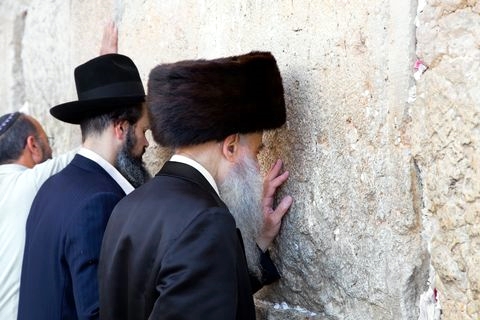
Jewish men praying at the Western (Wailing) Wall, part of the retaining structure surrounding the Temple Mount.
Jews and Christians have been restricted since 2008 from even moving their lips in prayer on the Mount, by a ruling of then Israel Public Security Minister Avi Dichter. (WND)
Just a year after the ruling, Temple Mount police officer Mahmoud Hativ arrested a Jewish woman and her father the day before her wedding, claiming he had moved his lips in prayer and she had been nodding her head.
The two said they were then misled into signing confessions when they signed their release forms.
“I asked them: ‘How would it be if we arrested a young lady for praying anywhere else in the State of Israel? Or maybe a Muslim woman for praying in Mecca?” the father said. (Arutz Sheva)
On the Temple Mount
On a visit to the Temple Mount, tourists and pilgrims see the prominent Dome of the Rock, built in AD 691, and the nearby Dome of the Tablets (also known as the Dome of the Spirits), built in the 16th century.
The Dome of the Rock actually sits on the traditional site of the First and Second Temples, and there are historical accounts that seem to confirm the Muslims deliberately built on top of the Temple foundations. (Temple Mount)
Some believe that the Temple may have been situated in the location of the Dome of the Tablets, as the name seems to suggest that this is the place where the Ark in the Holy of Holies kept the Ten Commandments.
There is also some evidence that indicates the Temple was located between the Dome of the Rock and the Al-Aqsa Mosque.
The Al-Aqsa Mosque itself is situated where Herod’s Royal Stoa or Portico—a place of commerce—is thought to have been located. This might have been the spot where Yeshua cleansed the Temple.
“Yeshua entered the Temple courts and drove out all who were buying and selling there. He overturned the tables of the money changers and the benches of those selling doves.” (Matthew 21:12–13)
While signs of the destruction of the Second Temple such as piles of stones and burn marks on portions of wall remain on the Mount, the exact location of the Jewish Temples is still debated, despite Israel’s profound commitment to the pursuit of archaeological evidence revealing the history of Israel.
The Waqf has prevented Israel from performing archaeological activity claiming such excavation would defile Islam.
However, the Waqf has been digging on the Mount and destroying artifacts that confirm an ancient Jewish presence there.
For instance, in 2007 the Waqf brought a bulldozer onto the Mount to dig a trench in order to replace a 40-year-old electric cable.
Such heavy machinery can endanger the treasures that lie below the man-made surface of the Mount.
“In such a special place, [the Waqf] should have conducted an organized and proper excavation. But this was done with bulldozers and mechanical tools,” said Hebrew University archaeologist Ehud Netzer, who discovered King Herod’s tomb. “Digging of this sort can cause damage.” (NationalGeographic)

Solomon’s Stables lie 12.5 meters (41 feet) under the southeastern corner of the Temple Mount. This photograph of the Stables was taken circa 1915.
The Committee for the Prevention of Destruction of Antiquities on the Temple Mount, a group comprised of archaeologists and intellectuals from the left and right, also criticized the improper excavation, saying it was “without real, professional and careful archaeological supervision involving meticulous documentation.” (Haaretz)
US citizen David Wein said that on a trip to the Temple Mount a couple years ago, he saw excavations being carried out.
“I think the Arabs are digging things and excavating Jewish artifacts, but where is a museum with the things they have found? This is an important part of our history,” Wein said. “We should at least be welcome there.”

Stairs leading to Solomon’s Stables, a Second Temple era storage area, which the Waqf transformed into yet another Temple Mount mosque in 1996.
There is much yet to be explored on the Temple Mount.
For instance, beneath the Temple Mount Platform, which is about 34 acres, are a variety of caves, chambers, cisterns and passageways that have probably not been entered since the Second Temple was destroyed by the Romans in AD 70.
The Tabernacle of Moses, which was dismantled when the First Temple was built by Solomon, might to be stored in a room underneath the Mount.
Some also think that the Ark of the Covenant—the only man-made object in the world considered to be holy—is also hidden away in a chamber underneath the Temple Mount just waiting to be discovered.
A Future Temple
Despite the objections raised by Muslims, the Temple Mount will continue to be cherished by Jews and Christians alike.
Visiting the Temple Mount is a deeply profound experience, Wein said.
“Being that close to the Holy of Holies brought a renewed perspective to my study of Torah because all the things we read in the Torah happened in a particular time and space, and I was a part of that space for a few minutes,” he said.
Furthermore, Bible prophecy makes it clear that a Third Temple will be built on the Temple Mount.
“In the last days, the mountain of the Lord’s Temple will be established as the highest of the mountains; it will be exalted above the hills, and all nations will stream to it. Many peoples will come and say, “Come, let us go up to the mountain of the Lord, to the Temple of the God of Jacob.” (Isaiah 2:2–3)
Yeshua confirmed the Third Temple, as well.
When discussing the last days with His talmidim (disciples), He said there would be a Holy Temple that would be defiled by a false Messiah before His return. (Matthew 24:15–21; see also 2 Thessalonians 2:1–4 and Revelation 11:1–2)
Indeed, in preparation for the Third Temple, the Temple Mount Institute has already created the sacred vessels and priestly garments.
Bible prophecy also promises that the Jewish People will return to the Lord and David their king in the last days. In other words, at that time, they will know that Yeshua (Jesus) is the King Messiah for whom they have been waiting. (Matthew 1:1)
“For the Israelites will live many days without king or prince, without sacrifice or sacred stones, without ephod or household gods. Afterward the Israelites will return and seek the LORD their God and David their king. They will come trembling to the LORD and to His blessings in the last days.” (Hosea 3:4–5)




